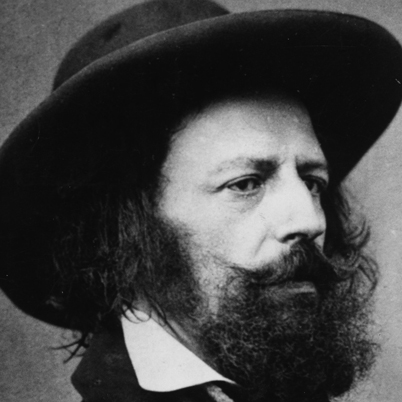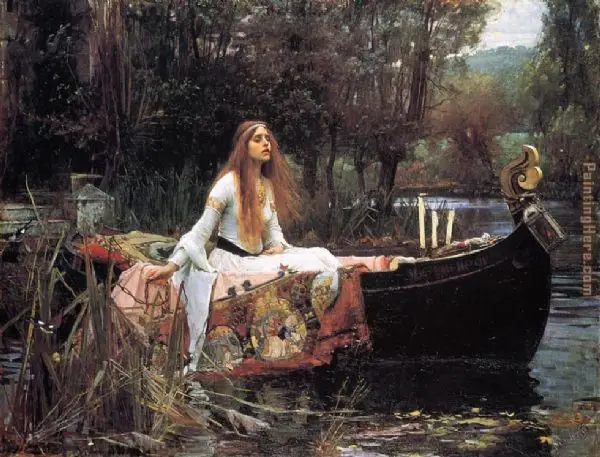Alfred Lord Tennyson, a Victorian poet, the first Baron Tennyson, was of British origin. He was born in Lincolnshire on the 6th of August, 1809. His works still echo not only in Ireland and Britain but also around the world. He gained acknowledgment for his poems in Cambridge after joining the Trinity College.
Jump straight to the text of poem “The Lady of Shallot”

There he also became a part of an undergraduate club called The Apostles. It was there that he met his beloved friend Arthur Henry Hallam who became quite an influential entity in Tennyson’s life. Unfortunately, Hallam died at 22, from an illness, which inspired Tennyson to pen ‘The Passing of Arthur,’ ‘Ulysses,’ ‘Tithonus,’ and ‘In Memoriam,’ out of immense grief.
While his early works were not much sought-after, his Poems of 1842 became the reason for his appointment as the Poet Laureate of England in 1850. He truly deserved the honour bestowed upon him. In 1892, at the age of 83, Alfred, Lord Tennyson died of Flu, in the United Kingdom.
See text of the poem “The Lady of Shallot”
The Inspiration Behind the Poem
The Lady of Shallot, Elaine fell in love with one of King Arthur’s fiercest knights, Sir Lancelot. He had stopped at her castle on his way to the jousting tournament. He had behaved like a gentleman with her and had not made any advances at her on his stay there. It was this mannerism that made Elaine fall for Sir Lancelot.
He told her and her family stories about the wars and the castles and sought help for disguising. To complete his disguise, Lancelot asked Elaine for the shield that was given to her by another knight. She wilfully granted him the other shield and swore to look after his shield.
Later on, Elaine confessed her love to Lancelot but failed to get the reciprocation from him. She was deeply affected by this and soon began going into a depression. The incident took a great toll on her health and she passed away in sorrow. She wrote a note before dying, wherein she expressed her last wish, which was to be buried by the hands of Sir Lancelot. Lancelot quite dutifully fulfilled her last wish without any questions.
An Overview of the Poem The Lady of Shallot
Alfred, Lord Tennyson’s The Lady of Shallot draws its inspiration from the above mentioned Arthurian legend. The poem is set in the medieval times, during King Arthur’s reign. The poem recites the story of The Lady of Shallot, who is confined inside a tower on an island near Camelot. She hears a voice that forbids her from looking down upon Camelot, otherwise, a curse might follow. She spends her time weaving a colourful magic web, singing carols, and looking into her mirror whenever she wishes to look at the outside world. She is tired of seeing deaths, young girls in the market, and young lovers getting married and longs to see someone who isn’t merely a shadow to her.
Just when she is “half sick of shadows,” she sees Sir Lancelot’s reflection in the mirror. He is shining in his knight’s armour, is wearing a helmet, and has “coal-black curls.” He is glowing as he rides down Camelot while singing “Tirra lirra.” Seeing him through the mirror, The Lady of Shallot is hit by an exciting urge to look at the town directly. She throws her magic web outside and as she looks upon Sir Lancelot, her mirror breaks and she finds herself under a haunting curse.
She dresses in a “snowy white” robe and even though the weather is stormy, she rushes towards the coastline of the river, finds a boat and writes “The Lady of Shallot” on it. In the cold weather, she rows her boat and sings merry carols. Slowly the chill freezes her blood and darkens her eyes and she dies while still sailing, before even reaching Camelot. She is discovered by the inhabitants there who wonder who she is. And while they look at her, they realise that the sound of the songs that usually came from the tower have stopped.
Right then, Lancelot appears and looks at the maiden’s face and says, “She has a lovely face. God in his mercy lend her grace, The Lady of Shallot.”
Literary Analysis of The Lady of Shallot
The poem is written in four parts, each depicting a different scenario. The first part of the poem describes the settings of the poem. Tennyson uses various vivid imagery in the poem to give birth to the reader’s imagination. The second part of the poem describes The Lady of Shallot and her environment.
The third part focuses on Sir Lancelot. It describes him. In the fourth part, which is the final part of the poem, the poem experiences the climax and finally, the denouement. It provides an end to the story of The Lady of Shallot and her one-sided love for Sir Lancelot.
Theme: The theme of the poem is ‘unrequited love,’ owing to the fact that The Lady of Shallot barely even got to Lancelot when alive. The theme can also be ‘isolation’ because it shows The Lady of Shallot imprisoned and lonely throughout the course of the poem.
Rhyme Scheme: The poem follows a rhyme scheme of a-a-a-a-b-c-c-c-b.
Stanza: Each stanza has nine lines in perfect rhyme.
Meter: The poem switches from Iambic meter to Trochaic Tetrameter.
Literary Devices: Repetition, alliteration, aphaeresis, imagery, personification, refrain, irony, allusion, paradox, metaphor, simile.
The Lady of Shallot has earned its glory and has been critically acclaimed since its inception. Alfred, Lord Tennyson makes us travel back to the medieval period and narrates a beautiful yet sorrow-filled story of a young maiden.
The poem depicts isolation, depression, social anxiety, misery but even so grants hope, regardless of the fact that it ends with the death of The Lady of Shallot. It provides pleasure to the reader and treasure to the literary lovers. It fulfils its purpose as literature in all aspects and leaves an everlasting impression, be it good or bad, on its reader.
Another legacy of The Lady of Shallot
Famous British painter John William Waterhouse was inspired by Tennyson’s poem and painted one of his famous works, rightfully titled “The Lady of Shallot“.

Read the full text of poem “The Lady of Shallot” and its explanation.